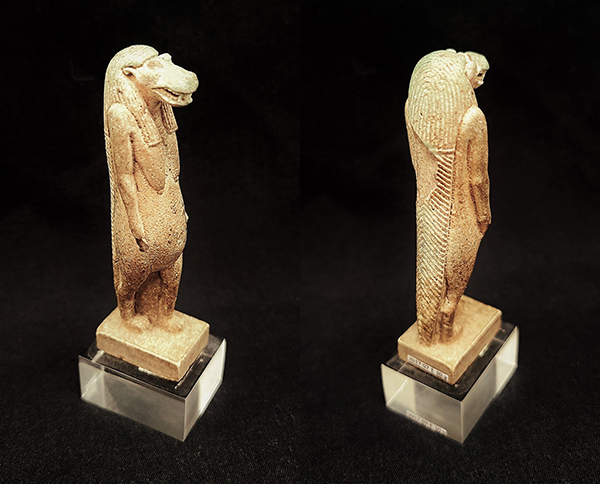Egyptian Taweret Amulet

This amulet dates to the Late Dynastic Period of ancient Egypt, between 664 and 332 BCE. It served as a personal devotional charm of Taweret, a goddess of childbirth and protector of women and children. Taweret was responsible for protecting women during pregnancy and childbirth by scaring off evil spirits who might harm the mother or child. She also assisted women with matters of sexuality and pregnancy. She was both nurturing and ferocious.
Taweret is represented by a combination of animals. She has the head and body of a pregnant hippopotamus standing upright. Her mouth is usually open to show her intimidating tusks. She has the paws of a lion and the back and tail of a crocodile. These fierce creatures, who were known to kill to protect their young, were both feared and respected by Egyptians, and they combine to produce a powerful deity. Her human breasts and hair show her nurturing and motherly side. Depicting her as pregnant demonstrates her capacity to raise children.
Taweret was a widely worshipped household deity who helped all Egyptian women regardless of social or economic status. She first appeared in the Old Kingdom (2686-2181 BCE) as the mother of the pharaoh. However, production of amulets in her image increased substantially in the New Kingdom (1550-1069 BCE) with the rise of more personal devotion. She was primarily worshipped through domestic shrines rather than large temples, reflecting a more intimate relationship with the goddess. Small amulets like this one, only 2 ¾ inches tall, were often carried by pregnant women.
Taweret eventually became popular beyond Egypt with depictions appearing in both Crete and Nubia. Additionally, some research indicates that she remains popular with modern day Egyptian women. For many years, women would rub the belly of a statue of Taweret at The Egyptian Museum in Cairo in hopes that the goddess would help them conceive. Although the statue is now behind protective glass, women reportedly still visit just to see her.
Other objects from ancient Egypt that have been featured for Artifact of the Month include a piece of mummy casing and an Isis figure.
